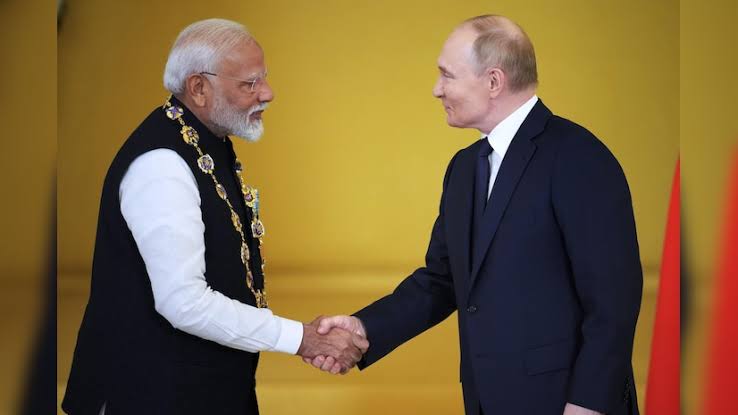India now 65% defence reliant, Majority of 35% from Russia/Israel/France, USA distant fourth

India is now overall, 65% reliant on indigenous weapons and equipment. So strategically speaking, over last few years it has begun reducing its reliance on defence imports.
Till now a majority of defence import was from our most trusted and reliable friend Russia. The Russian defence equipment import was not only quite affordable but they also proved to be very rugged and reliable in actual use, as seen in 1965, 1971, Kargil Wars and even in the recent Operation Sindoor. Now this shift from import to self reliance has marked a significant break from decades of dependence on imported arms.
Most of the bulk items earlier being imported from Russia have now been designed in India and being made in India. Though for certain type of latest technologies and to ensure diversification not readily available with Russia, India has turned to France, Israel and few other European suppliers. Then for certain cutting edge technologies, to be used as gap fillers till own technology matures, India has also turned to the USA. Thus over all, import of defence equipment from Russia has reduced and will continue to reduce as India keeps increasing its self reliance.
This shift may be a big deal for American defence companies, who are now landing contracts worth billions, but for India, this does not mean that it is “ dumping “ its most reliable and strategic partner – Russia.
Speaking at the US-India Strategic Partnership Forum, US Commerce Secretary Howard Lutnick said, “You should expect a (trade) deal between the United States and India in the not too distant future.” He also noted progress in having the” right people “ involved in the negotiations!!!!!
However, where Lutnic went completely wrong was when he talked about the factor of previously strained relations due to India’s preference for buying military equipment from Russia. Lutnick pointed out that India is now starting to purchase military equipment from the United States, which is a positive step. Well dear Mr Lutnick we still prefer Russia because unlike USA they hardly have any strings attached to their defence sales.
USA actually forgets that India is not begging for defence equipment as a military aid like Pakistan or many other countries. Our approach is commercial albeit from a friendly trader. However no matter what, a Shopkeeper cannot dictate to its customer — at least not to India.
India’s defence imports have plummeted from 76% in 2009 to just 36% last year, according to the Stockholm International Peace Research Institute (SIPRI) and naturally most of this reduction has taken place with respect to Russian imports. This is the first time since the 1960s that Russia’s share fell below half. The change reflects Prime Minister Narendra Modi’s strategy to make things in India, move towards 100% self reliance and also to diversify purchases. However India will continue to buy Russian oil despite sanctions and tantrums of USA and Western Countries. India will also maintain strategic friendship and diplomatic ties with Russia.
Joint projects with Russia, such as manufacturing next version/generation of deadly unbeatable BRAHMOS will continue. Also it is most likely that advanced fighter jet SU57 MKI may be bought by India as a gap filler till own AMCA starts entering IAF inventory. The USA F35 is certainly not suitable for IAF and India is just not interested in that costly toy. Though most hilariously a fewAmericans are bent upon selling their outdated F21 to India even after total snubbing received.
A proposal to lease may be upto four nuclear-powered attack submarine for the Indian Navy may also be in the offing as own SSGN will be ready only from 2035 ownwards. Presently the only pending Russian deliveries are one warship( will leave for India this month. Two pending S400 missile squadrons ordered in teeth of American threats will arrive in 2026.) In fact in the light of Operation Sindoor, as gap fillers two more squadrons of the most reliable S400 may be ordered, till own Project KUSHA is fully on Line.
Russia deputy chief of mission, Roman Babushkin, confirmed that the S400 contract is on track with no delays. This is significant especially considering its overwhelming success during the recent OP Sindoor.This follows India’s $5.43 billion deal signed in 2018 for five squadrons. Three of the five planned squadrons have already been delivered.
Since 2018, India has also signed contracts worth nearly $20 billion for US-made defence equipment, a clear plan of diversification for getting edge technologies but in no way tilting towards any military partnership with USA against China. The country recently approved a $3 billion deal for 31 long-range drones from General Atomics. India’s state-owned Hindustan Aeronautics Ltd. (HAL) and General Electric are close to finalising a deal to jointly produce advanced jet engines for India’s next generation of fighter aircraft. These agreements began taking shape during Modi’s 2023 visit to the US.
Modi’s foreign policy aims for India to be an independent Geopolitical pole in the Multipolar World. So it has been reducing its military imports, diversifying purchases and at the same time increasing self reliance. India will continue to buy discounted Russian oil and offers diplomatic backing. Meanwhile, it will buy advanced technology from USA but without strings attached and also go for defence partnerships. The US can strengthen its defence relationship with India only if it is based on equality. India unlike Britain or Canada will not be an American poodle. Washington will also face reciprocal tariff challenges from India, Trump should not be in any doubt.
In fact India has quietly noted the IMF loan to Pakistan right after OP Sindoor and will surely reciprocate, the Pakistani backers should not remain in any doubt. Now all supporters of Paki terrorism too have to pay.
India has no doubts about the functionality and robustness about Russian equipment and its quality. In fact the current OP Sindoor has removed all notions of infallibility of Chinese, Turkish and American equipment all over the World. Western talks regarding the MiG-29K fighter jets are pure bunkum. Pakistan began shivering, the moment INS VIKRANT armed with MiG29s neared area off Karachi coast.
Moreover, India’s indigenous fighter jet programme has stalled partly because the US-based General Electric struggled to supply jet engines. This highlights challenges in placing any trust in American Companies and their tech transfers. Other important items too are coming only in a slow motion.
India has earmarked $100 billion for future arms procurement, creating a vast opportunity for Western suppliers willing to co-produce and transfer technology. This opening benefits firms eager to deepen defence ties and help India build a modern, self-reliant military industry. India and the United States have entered a new phase in their defence relationship under a 10-year framework signed during Prime Minister Narendra Modi’s visit to Washington. The agreement, jointly announced with President Donald Trump, positions India as a key defence partner in the 21st century and formalises deeper cooperation in arms procurement, co-development, and regional security. However most of these companies, as seen will be from France, Spain, Israel and Italy and not grading because of their tantrums and superiority complex.
Following Trump’s re-election in early 2025, Washington is trying to accelerate defence sales to New Delhi. Talks are set to begin this year on a Reciprocal Defence Procurement (RDP) agreement to align procurement systems and ensure mutual supply of defence goods and services. This will mark a step forward in industrial integration only if based on equality, sans strings.
Over the last decade, India has increased its inventory of US-origin platforms for filling essential gaps only. These include airlift and surveillance assets such as the C-130J Super Hercules, C-17 Globemaster III, and P-8I Poseidon, as well as helicopters like the CH-47F Chinook and MH-60R Seahawk. Attack platforms include the AH-64E Apache and Harpoon anti-ship missiles. Artillery systems like the M777 howitzer and the long-endurance MQ-9B drones also feature prominently.
New co-production proposals for the Javelin anti-tank guided missiles and Stryker infantry combat vehicles are under discussion but unlikely to fructify as they are mere costly toys. Though the procurement of six more P-8I aircraft is expected to conclude this year, strengthening India’s maritime surveillance in the Indian Ocean. In fact India should be going in for another six.
Partnerships between US defence companies and Indian firms are being pursued too. One such effort is the collaboration between Anduril Industries and Mahindra Group to co-develop autonomous maritime systems and an AI-enabled counter-UAS platform. L3 Harris is also working with Bharat Electronics to develop active towed array sonar systems for anti-submarine warfare.
The US is also reviewing its policies on the transfer of fifth-generation fighter jets and undersea technologies to India. This signals a possible shift in export control norms that have long limited high-end technology transfer. Though India has made it clear that it is not interested in F35.
While the bilateral framework has evolved significantly since 2015, especially with the signing of foundational agreements like LEMOA, COMCASA, and BECA, cooperation in defence technology has been slow to mature. Earlier attempts under the Defence Technology and Trade Initiative (DTTI) suffered from delays in concluding frameworks and limited progress in co-development.
To provide renewed momentum, both sides have been working under the Initiative on Critical and Emerging Technologies (iCET), launched in January 2023. It serves as an umbrella for civil and defence technology cooperation and is linked to the broader strategic trade dialogue.
Despite progress, hurdles remain. Differences in intellectual property rights, commercial terms, and security safeguards continue to limit deeper technological integration. There is also concern over stringent controls placed on black-box components and software by US firms which will be rejected by India outrightly. ….remain shopkeepers don’t try and dictate simple.
The India-US Defence Acceleration Ecosystem (INDUS-X), launched in 2023, is another important pillar of the defence relationship. It connects India’s iDEX and the US Defence Innovation Unit (DIU) to drive joint innovation. The initial rounds under the INDUS-X Mutual Promotion of Advanced Collaborative Technologies (IMPACT) have already targeted areas like undersea communications and oil spill detection.
Meetings between defence investors and start-ups, as well as academic workshops, have laid the groundwork. However, implementation challenges—such as funding and integration of innovations into operational platforms—remain critical.
Two projects are set to define this phase of cooperation. The first is the GE–HAL agreement to co-produce the GE-F414 jet engine, with the final contract expected soon. The second is India’s acquisition of 31 MQ-9B drones, including plans for local assembly and global maintenance, repair and overhaul (MRO) services in India.
These deals, though not born directly from the roadmap for industrial cooperation signed in June 2023, align closely with its goals of boosting local manufacturing, increasing technology transfer, and diversifying India’s defence supply chains.
Several Indian companies are now actively supplying components to US defence manufacturers. This integration has advanced significantly over the past decade, setting the stage for more ambitious industrial cooperation in the years ahead.
Officials on both sides agree: the frameworks are in place, but execution must now take precedence. There is broad consensus on the need to announce new co-development and R&D projects in 2025 and 2026, especially in strategic areas like artificial intelligence, unmanned systems, and cyber defence.
The update of the 2015 Framework for Defence Relations is also due later this year. As the two nations navigate challenges commercial risk, and industrial coordination, India–US defence cooperation in 2025 has reached a pivotal moment—no longer limited to declarations, but geared towards delivery.




